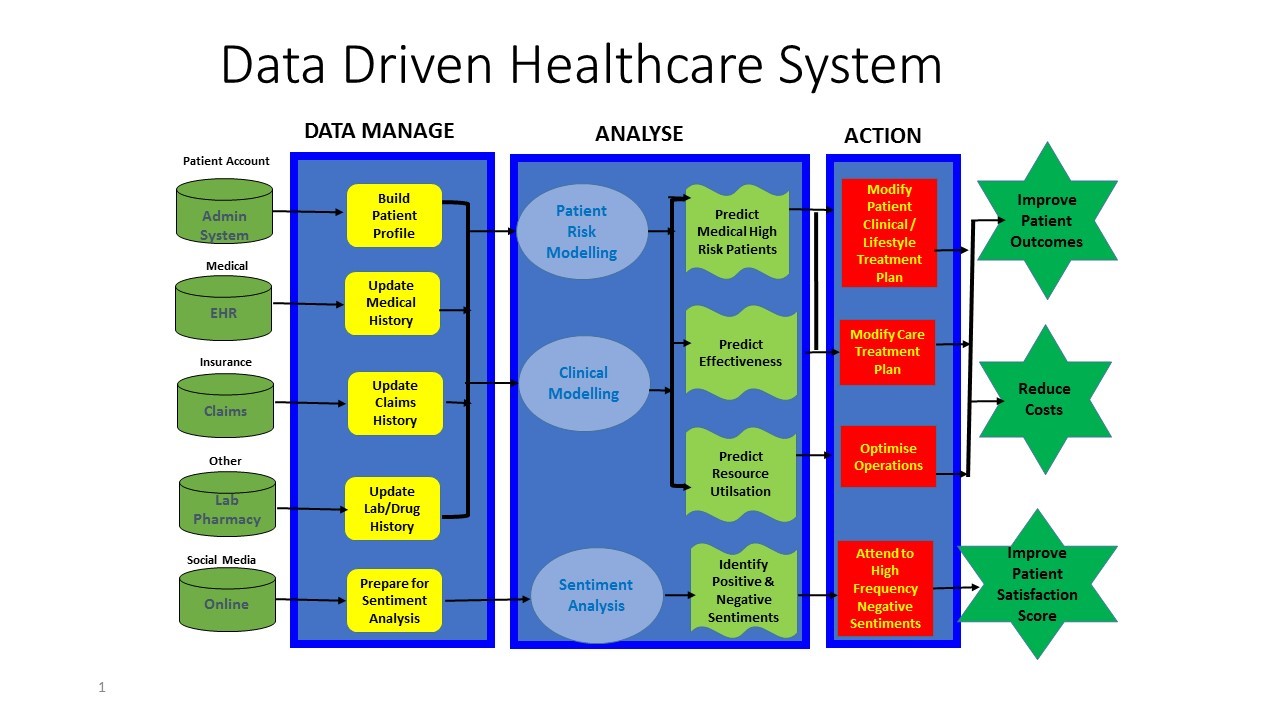Electronic health records contain many answers to better healthcare. Innovation in data integration and cutting-edge analytics are key to unlocking the wealth of knowledge secreted in these data.
The world is at the cusp of a breakthrough in patient care.
The phenomenal amount of data contained in the patients' electronic health records, sensor readings, insurance plans, demographic, dietary habits, genome sequencing, medical statistics and other data sources are pushing the boundaries of medical care towards a tipping point where pharmaceutical companies, healthcare providers and insurance companies may soon be able to tailor products and services to the specific needs of each patient.
By then, patients could expect greater visibility of treatment processes and outcomes that the integrated data would readily provide and consider these options alongside the expert opinions of health providers. It would give the patients more control over decisions regarding their own health and herald a healthcare transformation that has the potential to dramatically reduce the cost of treatment and improve patient care globally.
Dr Carol Hargreaves, Chief of NUS-ISS' Master of Technology Enterprise Business Analytics Programme, believes the opportunities would be enormous, "The level of insights and transparency that analytics could provide patients and healthcare providers alike is promising to revolutionalise the healthcare industry."

Figure 1.1 An example of a data-driven healthcare systems
She believes that analytics would enable healthcare services to become more evidence-based and organisations to adapt more quickly to emerging trends and shifting demographic.
The spillover effects would be in new medical discoveries as well as industry-wide innovations from medicine and physiotherapy to pharmaceuticals, sports and insurance.
But just how big is this opportunity?
A report by McKinsey & Company estimated it could save up to US$450 billion a year in terms of medical costs in the US alone; and more than US$3 billion had been invested in healthcare analytical systems and data-capturing smartphone applications since 2013, according to Mercom Capital Group . A more recent report by PwC showed that some 95% of healthcare executives in Singapore were looking to analytics to improve productivity .
According to Dr Hargreaves, to tap on these opportunities would require asking the right questions so that the right data could be collected to generate useful analyses with real world applications.
“Different stakeholders have different priorities and goals and data analysis makes sense only if it’s working to answer specific issues,” she adds.
Most patients, for instance, will want to benchmark their health statuses against the norm and compare drug or treatment outcomes. She cited the case of a stage 2 cancer patient who was recommended to go for chemotherapy. Her husband, who had access to the results of various cancer treatments, did an analysis of women within her age group and with similar conditions, and found out that another treatment would have a better success rate. With that information, the couple were able to consider a less drastic treatment and be more involved in their own welfare.
In commercial applications, analytics could help pharmaceuticals predict sales patterns by geography, insurance companies to set the correct premiums and healthcare providers to allocate resources and improve productivity. Several projects are already underway in Singapore’s public hospitals to cut admissions and Accident and Emergency cases to maximise the strapped resources .
Despite the strong interests and ongoing efforts, there are still many challenges that the industry has to overcome before the full potential of analytics could be realised. One of them is data silos.
The strength of analytics is in its ability to integrate data and information, often from different sources, to reveal valuable patterns and insights. There is, however, still a great inertia for organisations to share data due to data security and privacy, “even when the identities of the patients would be removed or encrypted as a matter of practice to protect patient confidentiality” according to Dr Hargreaves.
“It may be a long road ahead or it may be not. We are seeing more organisations opting in to share the databases and that’s encouraging.” says Dr Hargreaves optimistically.
One thing is for certain. Once the value of healthcare analytics is demonstrated through projects and experiments that are currently going on internationally, there would be a deluge of demands for reliable healthcare insights and information by the patients, public, healthcare industry, NGOs and government. That is basically everyone in the world.
Contact Dr Carol Hargreaves at +65 6601 2391 or isscah@nus.edu.sg to learn more about healthcare analytics. Dr Hargreaves is currently researching, consulting and teaching Predictive Analytics and Customer Analytics at NUS-ISS.
NUS-ISS conducts several analytics courses, including the popular Cutting Edge Business Analytics seminars and the WDA-accredited NICF - Customer Analytics.